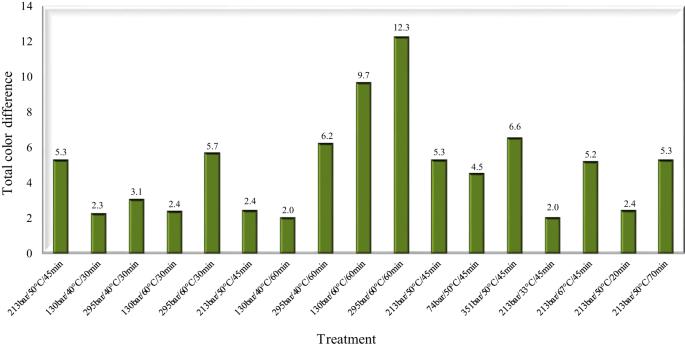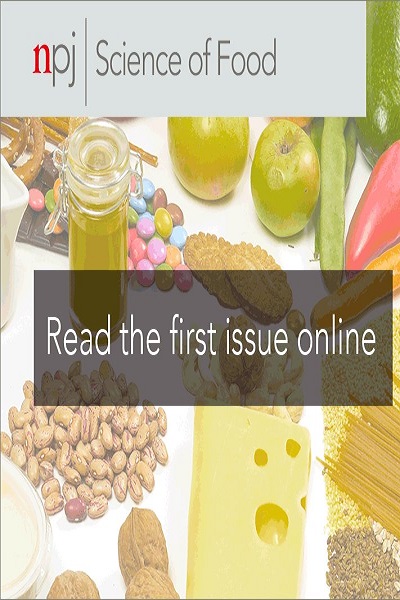The potential use of supercritical carbon dioxide in sugarcane juice processing
IF 6.3
1区 农林科学
Q1 FOOD SCIENCE & TECHNOLOGY
引用次数: 0
Abstract
Sugarcane juice is a nutritious and energetic drink. For its processing, the use of supercritical carbon dioxide (SC-CO2) technology as an intervention potentially capable of rendering a high quality product can be considered. This study evaluated the combined effect of SC-CO2 and mild temperatures, primarily aiming for the reduction of endogenous microorganisms and enzymes in sugarcane juice (pH~5.5). Pressures (P) ranging from 74 to 351 bar, temperatures (T) between 33 and 67 °C, and holding times (t) between 20 and 70 min were tested in a central composite rotational design. Seventeen trials were performed, comprising three replicates at the central points. Counts of aerobic mesophiles, molds and yeasts, lactic acid bacteria and coliforms at 45 °C, determination of polyphenol oxidase (PPO) and peroxidase (POD) activities, and measurement of color parameters in freshly extracted and processed juice’s samples were carried out. The pH of fresh and processed juice varied between 4.6 and 6.0, and between 4.6 and 6.3, respectively. The number of decimal reductions achieved in mesophiles, molds and yeasts, lactic acid bacteria and coliforms varied between 0.1 and 3.9, 2.1 and 4.1, 0.0 and 2.1, and 0.3 to 2.5, respectively. The percentages of PPO reduction ranged from 3.51% to 64.18%. Regarding the POD, reductions between 0.27% and 41.42% were obtained. Color variations between fresh and processed samples varied between 2.0 and 12.3. As for mesophiles, molds and yeasts reduction, and soluble solids variation, none of the variables or their interactions were significant. In terms of polyphenol oxidase (PPO) reduction, only t was significant; however, T, t, and the interaction between them significantly affected the peroxidase (POD) reduction. In regards to pH variation, P, and the interaction between T and t were significant. P, T, t, and the interaction between T and t played a significant effect on color. The combination of mild temperatures and SC-CO2 can be potentially used for cane juice preservation.

超临界二氧化碳在甘蔗汁加工中的潜在用途
甘蔗汁是一种营养丰富、充满活力的饮料。在加工甘蔗汁时,可以考虑使用超临界二氧化碳(SC-CO2)技术作为一种干预措施,以获得高质量的产品。本研究评估了超临界二氧化碳和温和温度的综合效果,主要目的是减少甘蔗汁(pH 值~5.5)中的内源微生物和酶。试验采用中心复合旋转设计,压力 (P) 为 74 至 351 巴,温度 (T) 为 33 至 67 °C,保温时间 (t) 为 20 至 70 分钟。共进行了 17 次试验,在中心点进行了三次重复。在 45 °C 下对需氧中嗜菌、霉菌和酵母菌、乳酸菌和大肠菌群进行了计数,测定了多酚氧化酶 (PPO) 和过氧化物酶 (POD) 的活性,并测量了新鲜提取果汁和加工果汁样品的颜色参数。新鲜果汁和加工果汁的 pH 值分别介于 4.6 和 6.0 之间,以及 4.6 和 6.3 之间。嗜中菌、霉菌和酵母菌、乳酸菌和大肠菌群的十进制减少数分别在 0.1 至 3.9、2.1 至 4.1、0.0 至 2.1 和 0.3 至 2.5 之间变化。PPO 的减少率从 3.51% 到 64.18% 不等。至于 POD,降幅在 0.27% 到 41.42% 之间。新鲜样品和加工样品之间的色差在 2.0 到 12.3 之间。至于嗜中菌、霉菌和酵母菌的减少以及可溶性固形物的变化,这些变量或它们之间的相互作用都不显著。就多酚氧化酶(PPO)的减少而言,只有 t 具有显著性;但是,T、t 以及它们之间的交互作用对过氧化物酶(POD)的减少有显著影响。在 pH 变化方面,P 以及 T 和 t 之间的交互作用具有显著性。P、T、t 以及 T 和 t 之间的交互作用对颜色有明显影响。温和的温度与 SC-CO2 的结合可用于甘蔗汁的保存。
本文章由计算机程序翻译,如有差异,请以英文原文为准。
求助全文
约1分钟内获得全文
求助全文
来源期刊

NPJ Science of Food
FOOD SCIENCE & TECHNOLOGY-
CiteScore
7.50
自引率
1.60%
发文量
53
期刊介绍:
npj Science of Food is an online-only and open access journal publishes high-quality, high-impact papers related to food safety, security, integrated production, processing and packaging, the changes and interactions of food components, and the influence on health and wellness properties of food. The journal will support fundamental studies that advance the science of food beyond the classic focus on processing, thereby addressing basic inquiries around food from the public and industry. It will also support research that might result in innovation of technologies and products that are public-friendly while promoting the United Nations sustainable development goals.
 求助内容:
求助内容: 应助结果提醒方式:
应助结果提醒方式:


